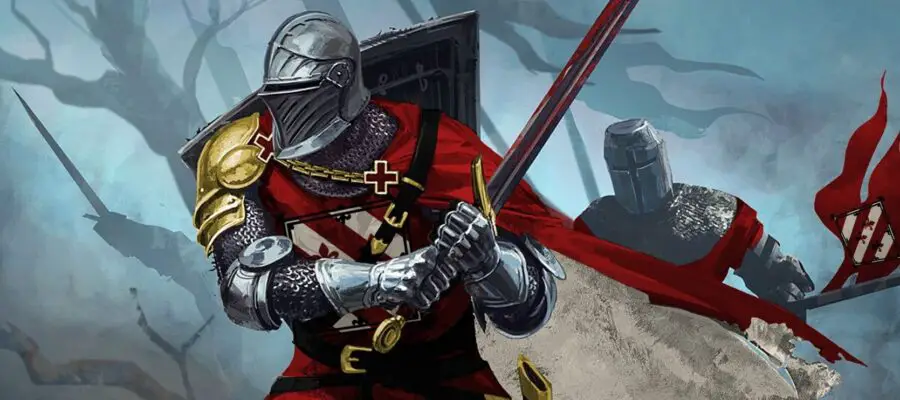Featured D&D 5e flanking art “(Aquitaine) Bourguignon Knight 1” by BretonniaHouseTyrell. Creative Commons License.
This article contains affiliate links that add gold to our coffers.
The DMG, p.251, suggests the optional rules that are hotly debated by D&D 5e players: flanking. It’s essentially an optional rule for teaming up on a surrounded enemy, giving you advantage to attack the creature you’ve encircled or boxed in. You need two or more characters to flank an enemy. Your rules for flanking will vary slightly if you use a hex map instead of a square grid. Flanking also requires seeing your enemy, so you can’t do it against an invisible or heavily obscured creature.
Are flanking rules fun? Are they well-designed? I’ve attempted to use them in several campaigns, but they never seem to stick. Players stop caring, and the DM stops caring, as flanking becomes a distant memory.
Why does this happen? Maybe flanking is inherently not fun because players don’t appreciate how valuable advantage on attack rolls is. Flanking could be tedious to maneuver as players and DMs constantly try to secure advantage from flanking. In the skewed words of Syndrome: “When everyone’s [flanking]… no one will be…” Flanking becomes the new default, so it isn’t fun or memorable. Even worse, it belittles entire class abilities that grant advantage, and all it costs you is standing in the right spot. That’s a bore, and it causes a literal breakdown of the game as combat devolves into arguments about whether someone is surrounded. You’re flanking the enemy while the enemy is flanking you as you all fight in a huddled mass of clanging blades and clamorous bards.
DMs get the worst part of the flanking gig. I’ve had DMs ask me how to run flanking without it becoming annoying for the DM. Being constantly asked about flanking from players in a tense moment is frustrating. The way players frequently ask about flanking reminds me of memes making fun of players always announcing they have darkvision when it’s dark.
What Makes a Game Mechanic Fun?
Game features are enjoyable when reliable, practical, unique, and earned. As it reads in the DMG, flanking’s benefit is not unique (gaining advantage). It’s worse than merely lacking uniqueness; flanking to gain advantage on an attack is so simple that it renders class features, feats, and other abilities that grant advantage to be trivial. There is hardly a point to obtaining an attack advantage from a class feature if any character can do the same by standing in the correct spot. Flanking is too accessible, and it doesn’t feel earned. This ruins much of the game’s fun for anyone trying to enjoy combat.
We need to fix the uniqueness and difficulty of achievement regarding flanking. Fixing these factors will make flanking fun. I’ll give suggestions in the next section, “Revising the Flanking Benefits.”
I also recommend helping the DM to have more fun with flanking. I don’t mean monsters surrounding the player characters. DMs have lamented about how using flanking was a pain in the hindquarters. Players ask too often if they have positioned themselves to flank an enemy. The rules are simple enough that players shouldn’t have to ask all the time. I recommend telling your players that they need to learn the flanking rules if they’re going to use them. If they are not diligent about it and they hound you with questions about whether they’re flanking, you can make a harsh ruling: anyone who asks if they’re flanking cannot gain its benefits for that round. “If you have to ask, you’re not.” Merely an example, but it can help if you’re pulling out your hair trying to mitigate the rules multiple times per round.
Revising the Flanking Benefits to Be Unique
I will brainstorm ideas for replacing the advantage granted by flanking rules with some other mechanical benefit. Let me know what you think of these ideas in the comments section below.
I mentioned earlier that a strategic benefit should feel unique. Advantage is statistically impactful, to be sure, but you can’t benefit from multiple instances of advantage on an attack. I know many people on Reddit and YouTube like to give a flat bonus of +2 to hit, and I think that’s alright… I appreciate that a +2 bonus sounds like the precedence set by cover rules, but I don’t get excited about it.
Flanking rules are especially beneficial to characters with multiple attacks. The more attacks you have, the more times you gain advantage or another custom benefit.
Let’s get into my ideas!
Flanking for a Wider Crit Range
I think it’d be cooler to afford flankers a wider range for critical hits. Flanking attacks would crit on natural 18-20 attack rolls. Critical hits are an exciting part of the game. Players love critical hits. Give them more opportunities to land critical hits when they are surrounding enemies! This would stack with other crit-range abilities like the Champion’s Improved Critical. You can think of the bonus as a -2 to the crit threshold (default 20). The Champion can crit on 19+, or 17+ while flanking. That’s about a 10% increase in a character’s chance to land a critical hit. This alternate rule isn’t perfect because some characters benefit from critical hits more than others, such as Rogues, Barbarians, and Paladins. Even then, this is a fun way to spice up flanking rules.
Flat Damage Bonuses for Flanking
Doubled Damage Bonuses from Stats: Melee weapon attacks already add flat bonus damage based on the relevant stat (usually Dexterity and Strength). Flanking could allow the damage modifier to be added twice to damage. Double the damage bonus of the relevant stat. Adding +4 to damage from a character’s Strength modifier will become +8 damage. This is simple to implement as the math is straightforward and doesn’t involve more dice. Of all my flat damage ideas, I like this one best.
Proficiency Bonus as Damage: Another flat bonus could be equal to a character’s Proficiency Bonus. It will scale as a character levels up, and they use it enough to always know what to add. It’s not the most exciting benefit, but it may be the simple concept you need.
Half Character Level as Damage: This is the largest flat-bonus idea I have that still sounds reasonable. It may even be too much. Add damage to an attack based on half of a character’s level (or monster’s CR). Make sure you’re rounding down. I don’t love this idea, but it may be more satisfying for some players who want to dish out tremendous amounts of damage.
Flanking AC Reduction
Pathfinder 2e uses a rule where flanking reduces a target’s AC by two. Here’s the context that makes that more interesting than a +2 to hit: Pathfinder rewards critical hits when attack rolls vastly exceed a target’s AC. If you have used this kind of house rule for critical hits above a given threshold exceeding AC, this may be the option for you.
Extra Damage Dice for Flanking
Hit Dice as Damage: Flanking could involve rolling extra damage dice. Let’s use the Hit Dice mechanic, but not actually expend Hit Dice. We’ll merely reference a character’s Hit Dice. A Wizard who is surrounding an enemy will gain 1d6 extra damage. Barbarians will gain 1d12 additional damage. This version of flanking will heavily favor martial classes that have the more significant Hit Dice potential.
Weapon Damage Dice: Not to be confused, this suggestion is to allow a weapon’s damage dice to be rolled twice. Magic items with extra dice already will not roll any dice more than the weapon types they are. Scimitars deal 1d6 damage, so they’ll deal 2d6 when surrounding an enemy.
Making Flanking Rarer, More Specialized
I’ve also seen the weird situation where a character is flanking a creature that is flanking them back. This happens when two players are on either side of a monster, but that monster and its ally are on either side of one of those players. To deal with this strange situation, I would rule that a creature that is being flanked cannot benefit from whatever flanking benefit is used in your game.
Flanking may be a tactic that requires extensive training to avoid overconfident strikes. Make flanking a feature that only works when a character has proficiency with at least one martial weapon and wields a martial weapon. That way, not just anyone can flank. You could even make flanking into a Fighting Style.
You might require a roleplaying moment for anyone who wants to flank. This makes flanking a storytelling incentive. Unfortunately, players probably want to flank because of the mechanical benefit. They might brush it off or half-heartedly roleplay it, especially if they’re forced to do it too often. Many mechanics are inherent to the game that can double as roleplaying. I’d ask the players to describe how they work in unison to attack a creature. Instead of feeling like you as the DM need to describe the attack, encourage them to do it. I recommend tempering this approach by allowing flank tactics as long as players are willing to narrate when you ask for roleplaying an attack.
Theater of the Mind and Roleplaying
If it has become very tiresome to get the “is it flanking” question, you could do away with it entirely. If you’re playing in person with a map and minis, it should be easy to determine if someone is flanked. Give players the DMG examples of how to determine if they’ve adequately surrounded an enemy.
Playing with the theater of the mind will mean you should probably omit flanking unless you want to be asked often if a character is surrounded. Tell players that you’ll err on the side of allowing flanking, so if they think they can do it, go for it.
You could even house rule that if they ask you if they’re flanking, they’re not, as I mentioned earlier. It’s a harsh rule, but so is going mad from being asked about flanking too often.
Conclusion
I once had a player from an old edition get visibly annoyed that the character he updated from a past edition couldn’t flank (I wasn’t employing flank rules). I said, ‘OK, let’s do it.’ He then got diced to pieces by a Githyanki gang. They surrounded him on the next turn after the player demanded flanking rules. And that wasn’t me being mean; he just dug his own grave at the exact moment it would get him sliced up. After that, nobody asked about flanking in that group! I’m not sure what method of resolving it is best for you and your players, but I hope my rambling has inspired you to some course of action.
Which of my ideas did you like? What ideas do you have for making flanking more fun? Misty Step to the comment section below to tell me your thoughts. I always enjoy talking about D&D.
You’ll also find suggested articles below. Please read or bookmark another piece you’re interested in! You can browse articles about D&D 5e homebrew here. Thank you for joining me today! Good luck in your next game.





He! As usual, a great article. I had another idea for this recently while playing a game on Xbox called Othercide. Its a turn based combat system. They have a flanking system that seems doable. Once a character or enemy is hit by melee, they are “locked” facing the direction of that first attack. Hits from the side give a slight bonus, but hits from behind give much higher bonuses. This lock is removed at the beginning of that creatures turn. It would require keeping up with what direction you are facing, so theater of mind would be nearly impossible. But a battle map would make this easier.
So the fighter engages with the enemy and attacks normally. On a hit, that enemy is now locked looking that fighters direction. If the barbarian now moves in from the side, they get one level of bonus, if they make it to the back they get a higher level of bonus. And those could be dm decided. Maybe from the side its a normal attack roll but it doubles up the str or dex damage bonus. And from behind it extends the crit range down to a base 18 or something like that.
Hi Ian, thank you for the compliment.
Your idea for locking a direction for a creature’s facing and position sounds really good to me. I have attempted to play D&D 5e before with the optional rules in the DMG for directional facing. I wanted players to have AC bonuses for the side of their body that their shields were on, bonuses for flanking, etc. After two sessions of trying to play this way, I could tell nobody really liked the system. They weren’t using it, and I didn’t have the patience to try and teach them. I had communicated my intention to use these rules in session zero, and the group seemed optimistic or indifferent to the style. I had battle maps so they could visualize everything. Oh well!
My conclusion was that I wouldn’t use those rules again unless I found a group that was PSYCHED to use them. Such a group would probably love combat and battle realism.
But like I said, I really like your way of doing it. I’d definitely use the “locked” directional facing concept if I were to try and run combat in this way again.
I see people talking about flanking a lot, and no one seems to see the real problem. You’ve mentioned it’s too easy to get flanking, but the mistake everyone makes is thinking the flanking rule is the problem. It’s not. The problem is that it’s too easy to get on the other side of someone. Or to put it another way, 5e characters have no ability to control a zone. The only way a martial has to stop movement around him is if he takes the Sentinel feat, and that only works once per turn as a reaction.
Back in 3.5/Pathfinder 1e, you provoked an attack of opportunity whenever you moved within an opponent’s reach. 5e changed this to whenever you left an opponent’s reach. (I don’t remember how 4e did it, but the combat engine was so different it hardly matters as a comparison). Under the old system, if you were standing in front of someone and wanted to slide around behind them, you’d eat as many as 4 opportunity attacks! More, the larger they are. Characters were effectively “sticky”. Flanking was more earned because once you engaged in melee, you had to take significant punishment to alter your position. Or just take your time with multiple 5-foot steps, but either way, a serious cost.
It’s not just flanking either, combat as a whole suffers from this and other similar, seemingly finnicky issues that reduce combat to a formless mush. In this case, 5e essentially allows anyone to be anywhere they want to be at any time in combat (within range of their movement), and that’s why flanking feels bad. Position based effects always feel unearned when position itself is meaningless.
I appreciate your perspective, but I don’t agree that what you described is “the real problem” with flanking in 5e. It’s just a difference with other systems. Apart from flanking, and addressing your points, the majority of complaints I’ve heard about 5e combat in general is that characters go to one spot and stay there, not that they can move around too freely.